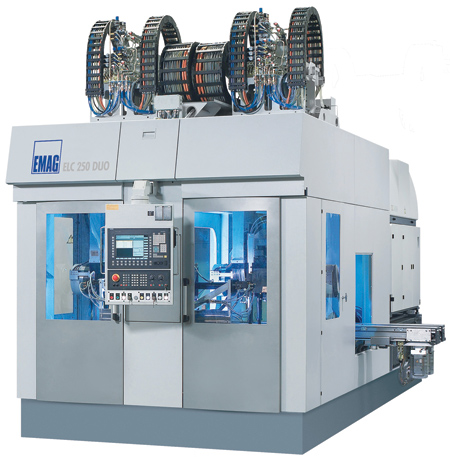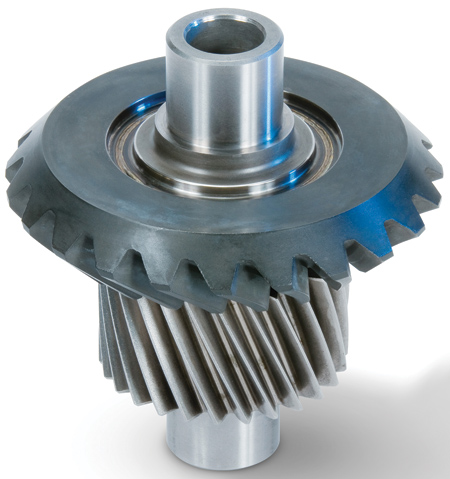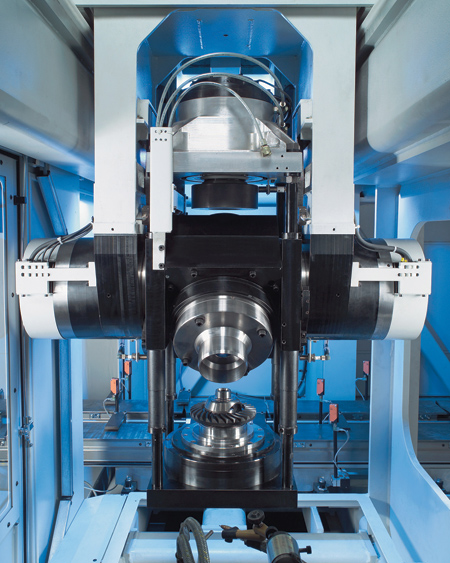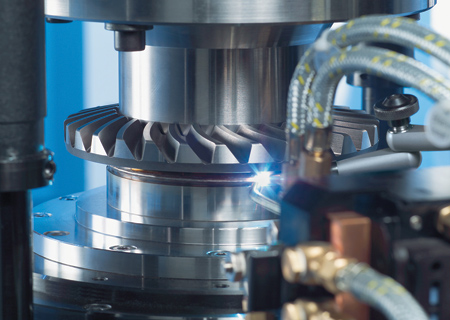
The ELC 250 DUO is a compact laser production center for machining differential housings. The duo version of the ELC has twin spindles. "This two-station mode allows the working spindles to be loaded and unloaded during the machining time," said a company spokesperson.

Laser welding the differential gearbox housing and the ring gear has allowed the component weight to be reduced by approximately 1.2 kg.

The ELC 250 DUO is fitted with two swiveling pickup spindles.

Laser welding a ring gear to a differential housing
"Whether hybrids, fully electric vehicles or power units with fuel cells, the future of mobility is far from clear and remains exciting," said a company spokesperson. "The one thing that is certain, however, is that changes will come for which the industry will have to find flexible solutions. Classic components, such as differential gearboxes, will continue to be manufactured regardless of the type of energy that powers the vehicle. EMAG provides manufacturing solutions for the entire differential gearbox, with the particularly highlighted laser welding systems for differential housings and ring gears based on the EMAG ELC 250 DUO Laser Cell.
"Optimizing the production of gearbox components has two main aspects: improving the component itself, for example in terms of quality and weight, and improving the production process to reduce component costs. Laser welding technology in general, and the ELC 250 DUO laser welding machine in particular, generate benefits in both areas.
"There are two arguments in favor of substituting the classic screw connection between a ring gear and differential housing: reducing weight and cost. The weight savings for a welded differential in a car engine is approximately 0.6 to 1.2 kg, a cost savings considering the reduced material consumption, the elimination of machining and the assembly for the high-strength screws required.
"Laser welding, however, offers its own unique challenges. While the differential housing is made of a cast material, the ring gear is made of case-hardened steel. As a result of the material hardness, welding cast is always a critical process, and it must be tailored to the specific component. There are no off-the-rack solutions. Another challenge is the pre-assembly of the differential gearbox housing. Contamination from previous production processes (oil, assembly pastes, etc.) can adversely affect the welding process, resulting in weld cracks. Cleaning the welding zone is therefore crucial, also for the ring gear generally surface-treated by phosphating that can also adversely affect the welding process and must be cleaned. To address these challenges, EMAG has already supplied more than 20 complete systems for the joining and laser welding of differential gearboxes, each tailored to the customer and their level of automation, flexibility, layout and process."
The ELC 250 DUO laser welding machine, developed and manufactured by EMAG Automation of the EMAG Group, is built with dual machining areas. "The twin-spindle design is consistent with the goal of the entire system to achieve maximum productivity," said the spokesperson. "To this end, the ELC 250 DUO uses the typical EMAG pickup principle of self-loading working spindles.
"There are several benefits to using pickup spindles. This principle allows fixed lenses to be used since the workpiece moves rather than the tool and it allows loading and unloading to take place during the cycle time to reduce idle times. The fact that the lenses are fixed ensures that the laser is always directed into the inside of the machine, guaranteeing an excellent level of protection for the user. Furthermore, fixed lenses ensure process reliability since all the laser technology and logistics for operating the laser must only be set up once. The advantages are operational safety and ease of servicing.
"The optical system is simple yet robust. EMAG has created a high-precision, heavy-duty production solution which provides a platform for reliable large series production. The optimized beam control and targeted extraction protect the lenses from contamination during the welding process. The ELC 250 DUO can be equipped with the latest laser technology to suit component requirements and the customer's specifications."
Although the process takes place on two stations within the ELC 250 DUO, only one laser source is required. A beam deflector is used to switch the laser between the focusing lenses at the two welding stations. "This improves the usage of the laser and increases the productivity of the laser welding system," said the spokesperson. "The entire system is enhanced by the basic, high precision of the machine, combined with its flexibility of equipment (additional sensors, brushes, tests, etc.)."
The spokesperson also reported the following benefits of laser welding:
- High power density
- High process speed
- Low heat stress and low component warpage.
EMAG Automation delivers custom manufacturing solutions for the laser beam welding of components for powertrain, steering shafts, camshafts and other vehicle systems. The company is a turn-key supplier that not only deals with the welding process and laser welding machine but also integrates the automation system with parts logistics, clamping devices, part cleaning systems and ultrasound testing equipment for manufacturing systems.
For more information contact:
Peter Loetzner
EMAG LLC
38800 Grand River Ave.
Farmington Hills, MI 48335
248-477-7440
info@usa.emag.com
www.emag.com
Southwest
AR
David Fitzgerald
EMAG LLC
Charlotte, NC
248-595-1117
dfitzgerald@emag.com
www.emag.com
NM
Peter Loetzner
EMAG LLC
38800 Grand River Ave.
Farmington Hills, MI 48335
248-442-6590
info@usa.emag.com
www.emag.com
LA, OK, TX
Ric Lorilla
EMAG LLC
Houston, TX
248-595-1530
rlorilla@emag.com
www.emag.com
Southeast
AL, FL, GA, MS, NC, SC, TN, VA
David Fitzgerald
EMAG LLC
Charlotte, NC
248-595-1117
dfitzgerald@emag.com
www.emag.com
Northeast
NY, PA
James Petiprin
EMAG LLC
38800 Grand River Ave.
Farmington Hills, MI 48335
248-910-8413
jpetiprin@emag.com
www.emag.com
CT, DE, MA, MD, ME, NH, NJ, RI, VT
Jonathan Chomicz
EMAG LLC
Hartford, CT
248-497-8526
jchomicz@emag.com
www.emag.com
WV
David Fitzgerald
EMAG LLC
Charlotte, NC
248-595-1117
dfitzgerald@emag.com
www.emag.com
Midwest
MI, OH
James Petiprin
EMAG LLC
38800 Grand River Ave.
Farmington Hills, MI 48335
248-910-8413
jpetiprin@emag.com
www.emag.com
IL, IN, WI
Tod Petrik
EMAG LLC
Chicago, IL
248-470-2646
tpetrik@emag.com
www.emag.com
IA, KS, MN, MO, NE, ND, SD
Bill Konetski
EMAG LLC
Minneapolis, MN
612-804-0857
bkonetski@emag.com
www.emag.com
KY
David Fitzgerald
EMAG LLC
Charlotte, NC
248-595-1117
dfitzgerald@emag.com
www.emag.com
West
AZ, CA, CO, ID, MT, NV, OR, UT, WA, WY
Peter Loetzner
EMAG LLC
38800 Grand River Ave.
Farmington Hills, MI 48335
248-442-6590
info@usa.emag.com
www.emag.com